Report on Teaching Mathematics to Diverse Learners in the Classroom
VerifiedAdded on 2022/08/31
|9
|2598
|19
Report
AI Summary
This report addresses the challenges and strategies for teaching mathematics to diverse groups of learners, focusing on boys, Aboriginal students, and gifted students. The report begins with a literature review of each learner group, highlighting their specific needs and behaviors in the mathematics classroom. It then proposes tailored teaching strategies, such as teamwork and collaboration for boys, simplified language and cultural sensitivity for Aboriginal students, and advanced activities for gifted students. The report further details practical classroom activities aligned with Stage 3 Measurement and Geometry and Working Mathematically outcomes, including dividing objects, using geometrical equipment, and providing advanced problem-solving tasks. The conclusion emphasizes the importance of differentiated instruction to meet the unique needs of all students, ensuring that each learner has the opportunity to succeed in mathematics. The report emphasizes the importance of adapting teaching methods and classroom activities to suit the varied needs of the students to ensure effective learning outcomes. The report provides an overview of teaching strategies to cater to these diverse learners.
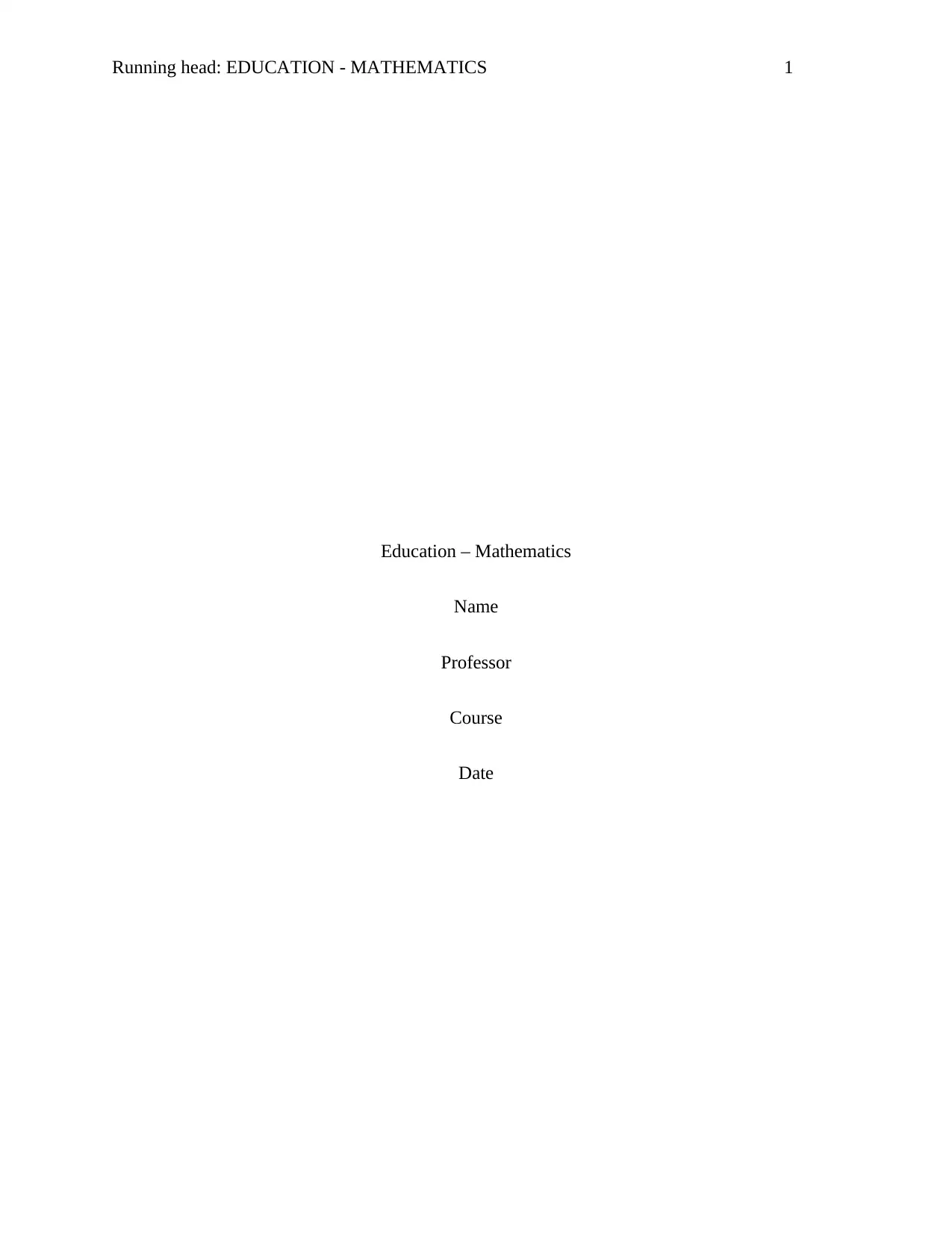
Running head: EDUCATION - MATHEMATICS 1
Education – Mathematics
Name
Professor
Course
Date
Education – Mathematics
Name
Professor
Course
Date
Paraphrase This Document
Need a fresh take? Get an instant paraphrase of this document with our AI Paraphraser
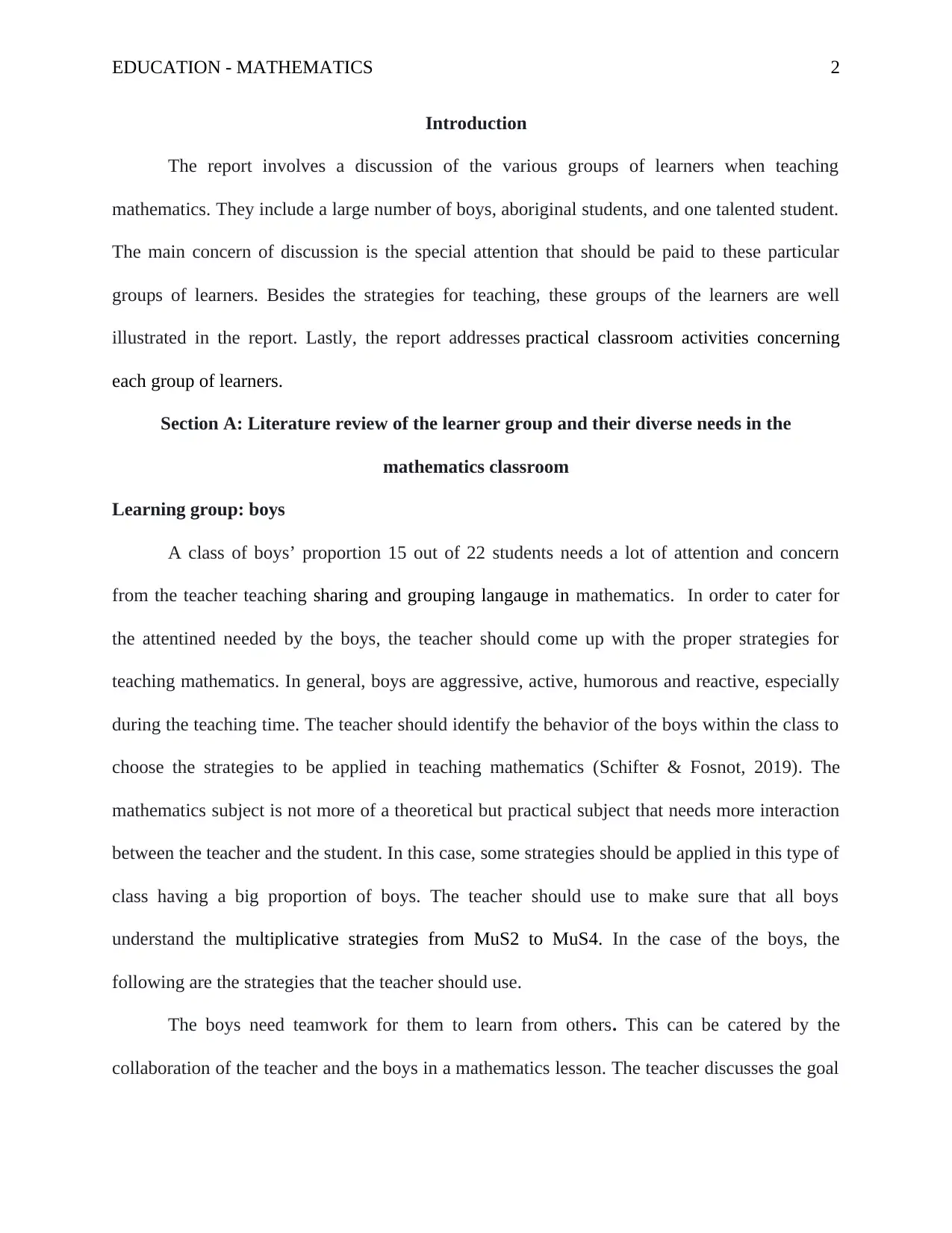
EDUCATION - MATHEMATICS 2
Introduction
The report involves a discussion of the various groups of learners when teaching
mathematics. They include a large number of boys, aboriginal students, and one talented student.
The main concern of discussion is the special attention that should be paid to these particular
groups of learners. Besides the strategies for teaching, these groups of the learners are well
illustrated in the report. Lastly, the report addresses practical classroom activities concerning
each group of learners.
Section A: Literature review of the learner group and their diverse needs in the
mathematics classroom
Learning group: boys
A class of boys’ proportion 15 out of 22 students needs a lot of attention and concern
from the teacher teaching sharing and grouping langauge in mathematics. In order to cater for
the attentined needed by the boys, the teacher should come up with the proper strategies for
teaching mathematics. In general, boys are aggressive, active, humorous and reactive, especially
during the teaching time. The teacher should identify the behavior of the boys within the class to
choose the strategies to be applied in teaching mathematics (Schifter & Fosnot, 2019). The
mathematics subject is not more of a theoretical but practical subject that needs more interaction
between the teacher and the student. In this case, some strategies should be applied in this type of
class having a big proportion of boys. The teacher should use to make sure that all boys
understand the multiplicative strategies from MuS2 to MuS4. In the case of the boys, the
following are the strategies that the teacher should use.
The boys need teamwork for them to learn from others. This can be catered by the
collaboration of the teacher and the boys in a mathematics lesson. The teacher discusses the goal
Introduction
The report involves a discussion of the various groups of learners when teaching
mathematics. They include a large number of boys, aboriginal students, and one talented student.
The main concern of discussion is the special attention that should be paid to these particular
groups of learners. Besides the strategies for teaching, these groups of the learners are well
illustrated in the report. Lastly, the report addresses practical classroom activities concerning
each group of learners.
Section A: Literature review of the learner group and their diverse needs in the
mathematics classroom
Learning group: boys
A class of boys’ proportion 15 out of 22 students needs a lot of attention and concern
from the teacher teaching sharing and grouping langauge in mathematics. In order to cater for
the attentined needed by the boys, the teacher should come up with the proper strategies for
teaching mathematics. In general, boys are aggressive, active, humorous and reactive, especially
during the teaching time. The teacher should identify the behavior of the boys within the class to
choose the strategies to be applied in teaching mathematics (Schifter & Fosnot, 2019). The
mathematics subject is not more of a theoretical but practical subject that needs more interaction
between the teacher and the student. In this case, some strategies should be applied in this type of
class having a big proportion of boys. The teacher should use to make sure that all boys
understand the multiplicative strategies from MuS2 to MuS4. In the case of the boys, the
following are the strategies that the teacher should use.
The boys need teamwork for them to learn from others. This can be catered by the
collaboration of the teacher and the boys in a mathematics lesson. The teacher discusses the goal
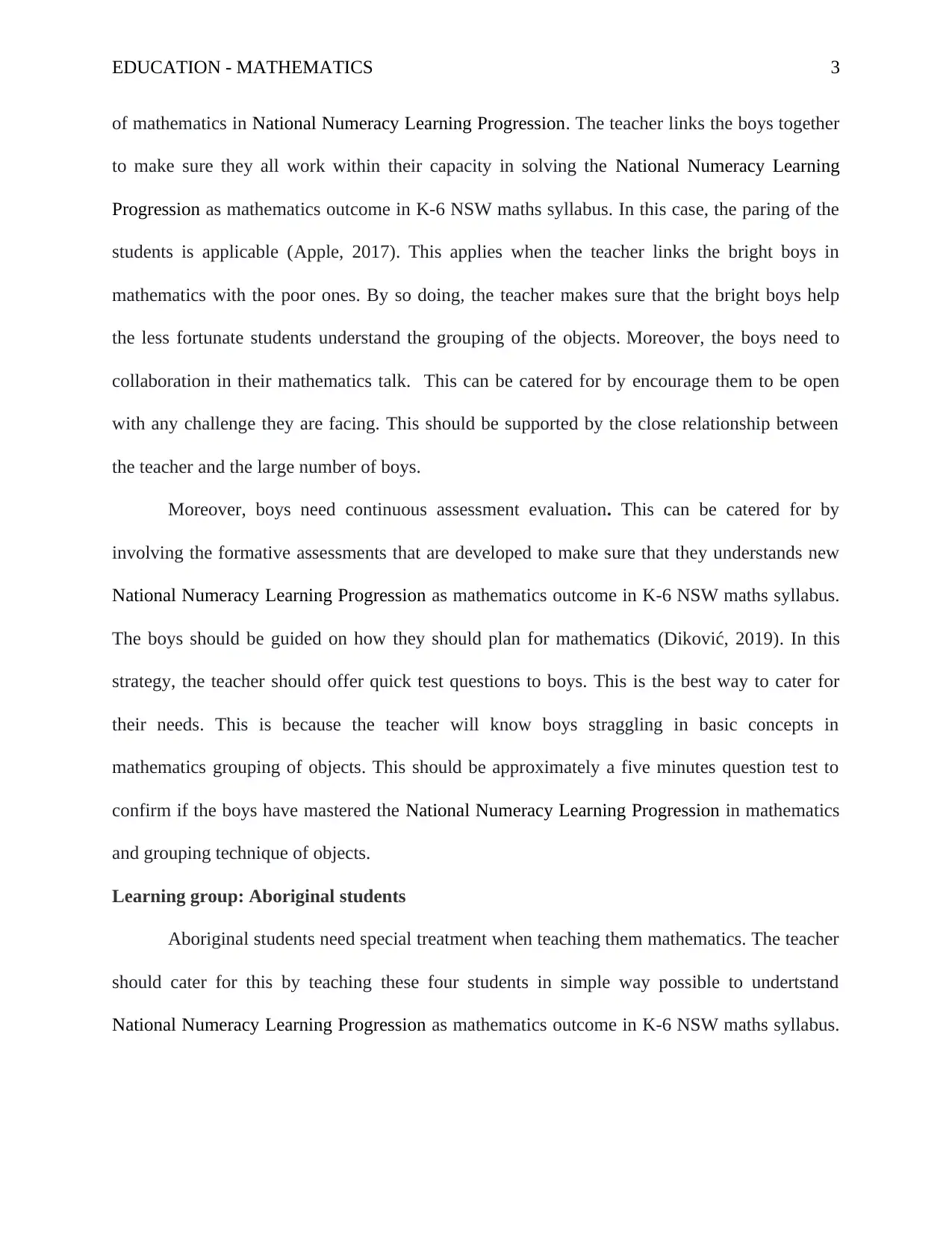
EDUCATION - MATHEMATICS 3
of mathematics in National Numeracy Learning Progression. The teacher links the boys together
to make sure they all work within their capacity in solving the National Numeracy Learning
Progression as mathematics outcome in K-6 NSW maths syllabus. In this case, the paring of the
students is applicable (Apple, 2017). This applies when the teacher links the bright boys in
mathematics with the poor ones. By so doing, the teacher makes sure that the bright boys help
the less fortunate students understand the grouping of the objects. Moreover, the boys need to
collaboration in their mathematics talk. This can be catered for by encourage them to be open
with any challenge they are facing. This should be supported by the close relationship between
the teacher and the large number of boys.
Moreover, boys need continuous assessment evaluation. This can be catered for by
involving the formative assessments that are developed to make sure that they understands new
National Numeracy Learning Progression as mathematics outcome in K-6 NSW maths syllabus.
The boys should be guided on how they should plan for mathematics (Diković, 2019). In this
strategy, the teacher should offer quick test questions to boys. This is the best way to cater for
their needs. This is because the teacher will know boys straggling in basic concepts in
mathematics grouping of objects. This should be approximately a five minutes question test to
confirm if the boys have mastered the National Numeracy Learning Progression in mathematics
and grouping technique of objects.
Learning group: Aboriginal students
Aboriginal students need special treatment when teaching them mathematics. The teacher
should cater for this by teaching these four students in simple way possible to undertstand
National Numeracy Learning Progression as mathematics outcome in K-6 NSW maths syllabus.
of mathematics in National Numeracy Learning Progression. The teacher links the boys together
to make sure they all work within their capacity in solving the National Numeracy Learning
Progression as mathematics outcome in K-6 NSW maths syllabus. In this case, the paring of the
students is applicable (Apple, 2017). This applies when the teacher links the bright boys in
mathematics with the poor ones. By so doing, the teacher makes sure that the bright boys help
the less fortunate students understand the grouping of the objects. Moreover, the boys need to
collaboration in their mathematics talk. This can be catered for by encourage them to be open
with any challenge they are facing. This should be supported by the close relationship between
the teacher and the large number of boys.
Moreover, boys need continuous assessment evaluation. This can be catered for by
involving the formative assessments that are developed to make sure that they understands new
National Numeracy Learning Progression as mathematics outcome in K-6 NSW maths syllabus.
The boys should be guided on how they should plan for mathematics (Diković, 2019). In this
strategy, the teacher should offer quick test questions to boys. This is the best way to cater for
their needs. This is because the teacher will know boys straggling in basic concepts in
mathematics grouping of objects. This should be approximately a five minutes question test to
confirm if the boys have mastered the National Numeracy Learning Progression in mathematics
and grouping technique of objects.
Learning group: Aboriginal students
Aboriginal students need special treatment when teaching them mathematics. The teacher
should cater for this by teaching these four students in simple way possible to undertstand
National Numeracy Learning Progression as mathematics outcome in K-6 NSW maths syllabus.
⊘ This is a preview!⊘
Do you want full access?
Subscribe today to unlock all pages.

Trusted by 1+ million students worldwide
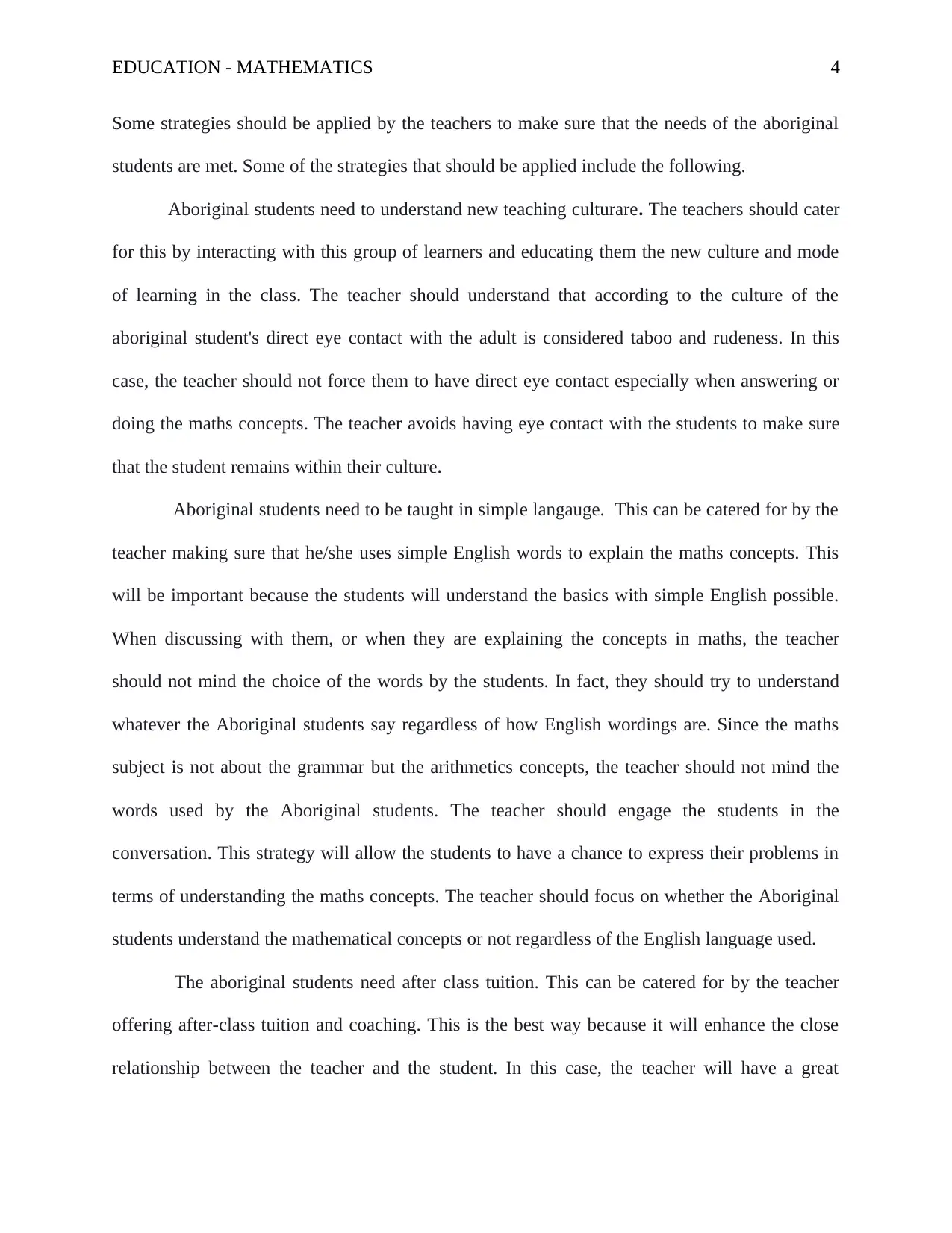
EDUCATION - MATHEMATICS 4
Some strategies should be applied by the teachers to make sure that the needs of the aboriginal
students are met. Some of the strategies that should be applied include the following.
Aboriginal students need to understand new teaching culturare. The teachers should cater
for this by interacting with this group of learners and educating them the new culture and mode
of learning in the class. The teacher should understand that according to the culture of the
aboriginal student's direct eye contact with the adult is considered taboo and rudeness. In this
case, the teacher should not force them to have direct eye contact especially when answering or
doing the maths concepts. The teacher avoids having eye contact with the students to make sure
that the student remains within their culture.
Aboriginal students need to be taught in simple langauge. This can be catered for by the
teacher making sure that he/she uses simple English words to explain the maths concepts. This
will be important because the students will understand the basics with simple English possible.
When discussing with them, or when they are explaining the concepts in maths, the teacher
should not mind the choice of the words by the students. In fact, they should try to understand
whatever the Aboriginal students say regardless of how English wordings are. Since the maths
subject is not about the grammar but the arithmetics concepts, the teacher should not mind the
words used by the Aboriginal students. The teacher should engage the students in the
conversation. This strategy will allow the students to have a chance to express their problems in
terms of understanding the maths concepts. The teacher should focus on whether the Aboriginal
students understand the mathematical concepts or not regardless of the English language used.
The aboriginal students need after class tuition. This can be catered for by the teacher
offering after-class tuition and coaching. This is the best way because it will enhance the close
relationship between the teacher and the student. In this case, the teacher will have a great
Some strategies should be applied by the teachers to make sure that the needs of the aboriginal
students are met. Some of the strategies that should be applied include the following.
Aboriginal students need to understand new teaching culturare. The teachers should cater
for this by interacting with this group of learners and educating them the new culture and mode
of learning in the class. The teacher should understand that according to the culture of the
aboriginal student's direct eye contact with the adult is considered taboo and rudeness. In this
case, the teacher should not force them to have direct eye contact especially when answering or
doing the maths concepts. The teacher avoids having eye contact with the students to make sure
that the student remains within their culture.
Aboriginal students need to be taught in simple langauge. This can be catered for by the
teacher making sure that he/she uses simple English words to explain the maths concepts. This
will be important because the students will understand the basics with simple English possible.
When discussing with them, or when they are explaining the concepts in maths, the teacher
should not mind the choice of the words by the students. In fact, they should try to understand
whatever the Aboriginal students say regardless of how English wordings are. Since the maths
subject is not about the grammar but the arithmetics concepts, the teacher should not mind the
words used by the Aboriginal students. The teacher should engage the students in the
conversation. This strategy will allow the students to have a chance to express their problems in
terms of understanding the maths concepts. The teacher should focus on whether the Aboriginal
students understand the mathematical concepts or not regardless of the English language used.
The aboriginal students need after class tuition. This can be catered for by the teacher
offering after-class tuition and coaching. This is the best way because it will enhance the close
relationship between the teacher and the student. In this case, the teacher will have a great
Paraphrase This Document
Need a fresh take? Get an instant paraphrase of this document with our AI Paraphraser
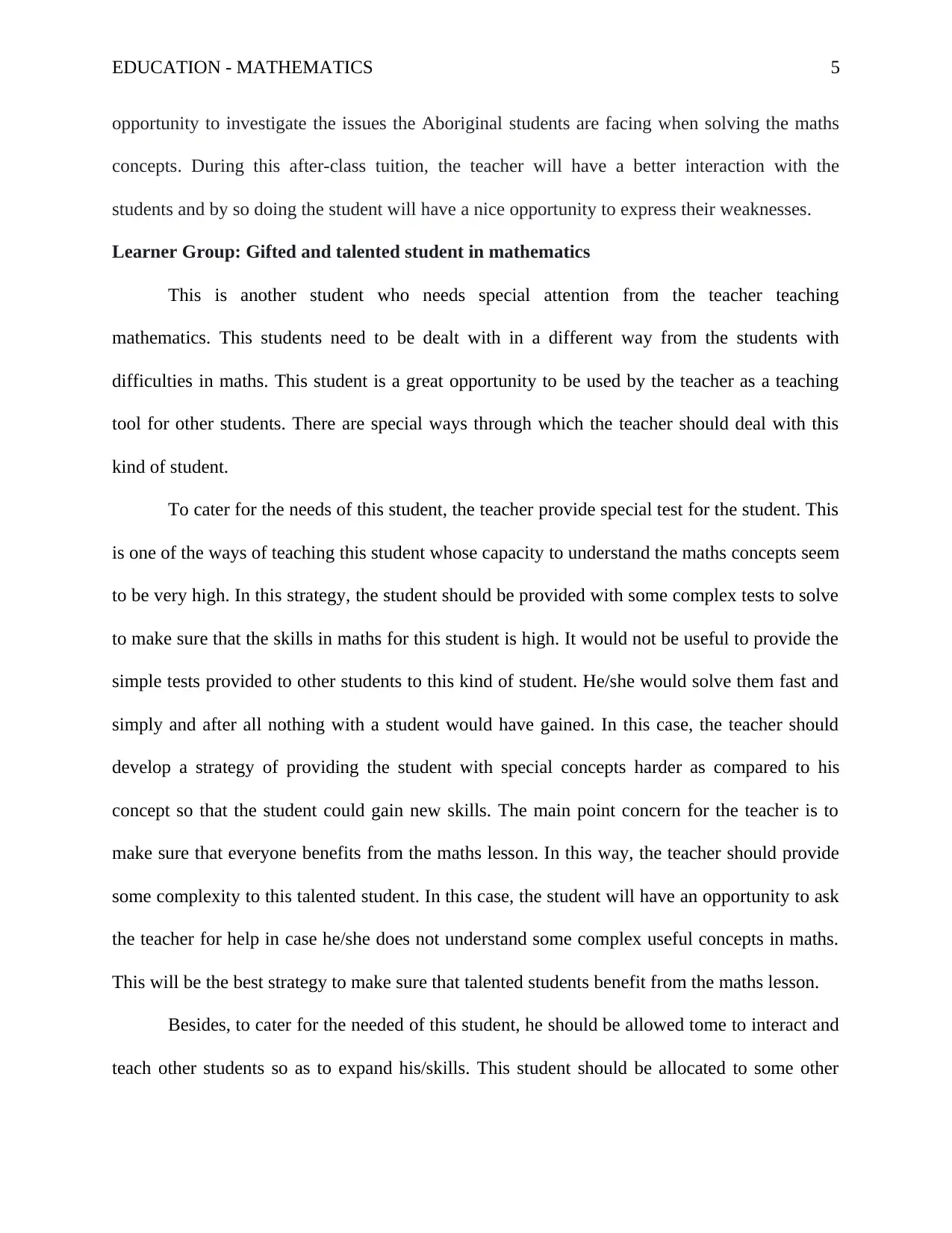
EDUCATION - MATHEMATICS 5
opportunity to investigate the issues the Aboriginal students are facing when solving the maths
concepts. During this after-class tuition, the teacher will have a better interaction with the
students and by so doing the student will have a nice opportunity to express their weaknesses.
Learner Group: Gifted and talented student in mathematics
This is another student who needs special attention from the teacher teaching
mathematics. This students need to be dealt with in a different way from the students with
difficulties in maths. This student is a great opportunity to be used by the teacher as a teaching
tool for other students. There are special ways through which the teacher should deal with this
kind of student.
To cater for the needs of this student, the teacher provide special test for the student. This
is one of the ways of teaching this student whose capacity to understand the maths concepts seem
to be very high. In this strategy, the student should be provided with some complex tests to solve
to make sure that the skills in maths for this student is high. It would not be useful to provide the
simple tests provided to other students to this kind of student. He/she would solve them fast and
simply and after all nothing with a student would have gained. In this case, the teacher should
develop a strategy of providing the student with special concepts harder as compared to his
concept so that the student could gain new skills. The main point concern for the teacher is to
make sure that everyone benefits from the maths lesson. In this way, the teacher should provide
some complexity to this talented student. In this case, the student will have an opportunity to ask
the teacher for help in case he/she does not understand some complex useful concepts in maths.
This will be the best strategy to make sure that talented students benefit from the maths lesson.
Besides, to cater for the needed of this student, he should be allowed tome to interact and
teach other students so as to expand his/skills. This student should be allocated to some other
opportunity to investigate the issues the Aboriginal students are facing when solving the maths
concepts. During this after-class tuition, the teacher will have a better interaction with the
students and by so doing the student will have a nice opportunity to express their weaknesses.
Learner Group: Gifted and talented student in mathematics
This is another student who needs special attention from the teacher teaching
mathematics. This students need to be dealt with in a different way from the students with
difficulties in maths. This student is a great opportunity to be used by the teacher as a teaching
tool for other students. There are special ways through which the teacher should deal with this
kind of student.
To cater for the needs of this student, the teacher provide special test for the student. This
is one of the ways of teaching this student whose capacity to understand the maths concepts seem
to be very high. In this strategy, the student should be provided with some complex tests to solve
to make sure that the skills in maths for this student is high. It would not be useful to provide the
simple tests provided to other students to this kind of student. He/she would solve them fast and
simply and after all nothing with a student would have gained. In this case, the teacher should
develop a strategy of providing the student with special concepts harder as compared to his
concept so that the student could gain new skills. The main point concern for the teacher is to
make sure that everyone benefits from the maths lesson. In this way, the teacher should provide
some complexity to this talented student. In this case, the student will have an opportunity to ask
the teacher for help in case he/she does not understand some complex useful concepts in maths.
This will be the best strategy to make sure that talented students benefit from the maths lesson.
Besides, to cater for the needed of this student, he should be allowed tome to interact and
teach other students so as to expand his/skills. This student should be allocated to some other
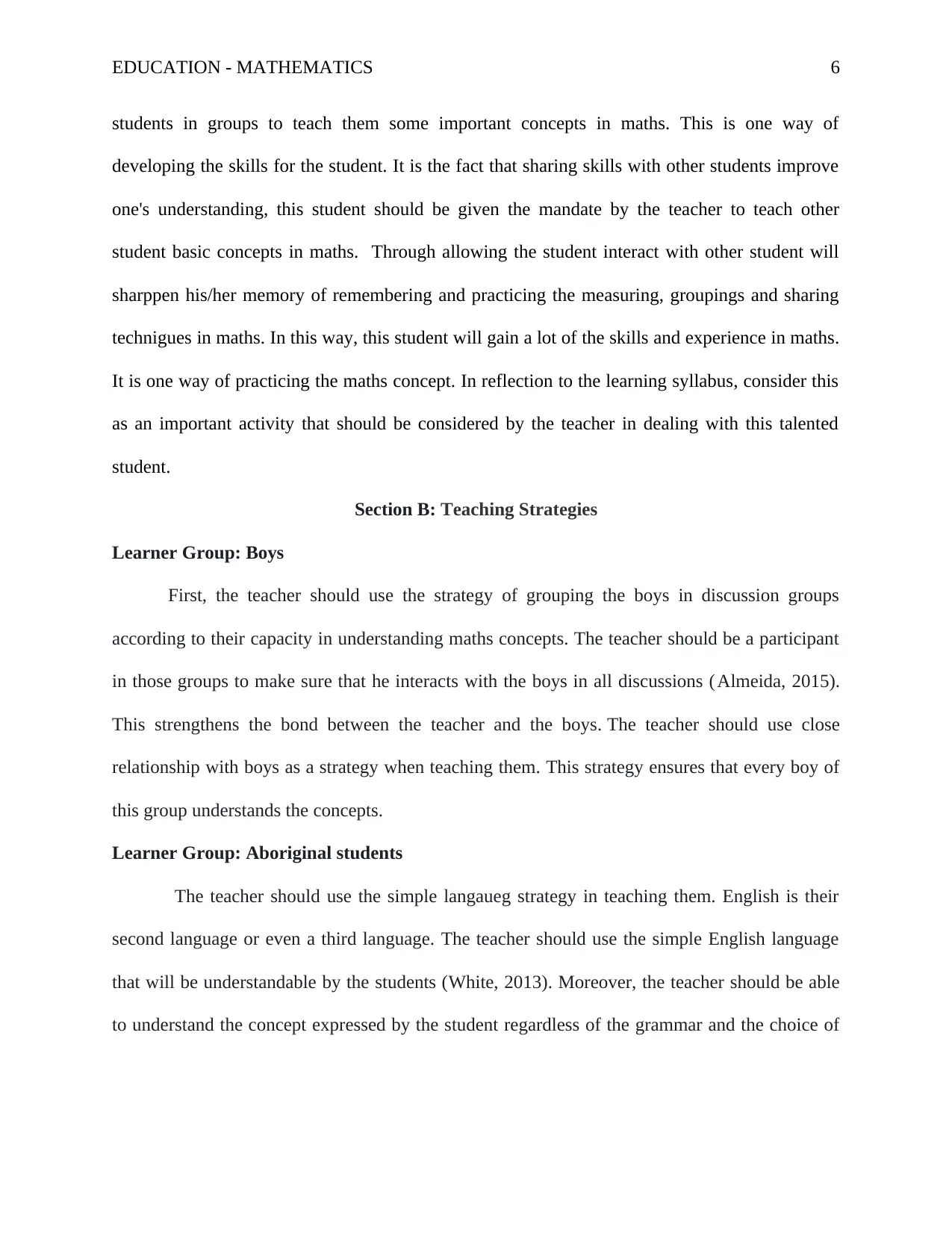
EDUCATION - MATHEMATICS 6
students in groups to teach them some important concepts in maths. This is one way of
developing the skills for the student. It is the fact that sharing skills with other students improve
one's understanding, this student should be given the mandate by the teacher to teach other
student basic concepts in maths. Through allowing the student interact with other student will
sharppen his/her memory of remembering and practicing the measuring, groupings and sharing
technigues in maths. In this way, this student will gain a lot of the skills and experience in maths.
It is one way of practicing the maths concept. In reflection to the learning syllabus, consider this
as an important activity that should be considered by the teacher in dealing with this talented
student.
Section B: Teaching Strategies
Learner Group: Boys
First, the teacher should use the strategy of grouping the boys in discussion groups
according to their capacity in understanding maths concepts. The teacher should be a participant
in those groups to make sure that he interacts with the boys in all discussions (Almeida, 2015).
This strengthens the bond between the teacher and the boys. The teacher should use close
relationship with boys as a strategy when teaching them. This strategy ensures that every boy of
this group understands the concepts.
Learner Group: Aboriginal students
The teacher should use the simple langaueg strategy in teaching them. English is their
second language or even a third language. The teacher should use the simple English language
that will be understandable by the students (White, 2013). Moreover, the teacher should be able
to understand the concept expressed by the student regardless of the grammar and the choice of
students in groups to teach them some important concepts in maths. This is one way of
developing the skills for the student. It is the fact that sharing skills with other students improve
one's understanding, this student should be given the mandate by the teacher to teach other
student basic concepts in maths. Through allowing the student interact with other student will
sharppen his/her memory of remembering and practicing the measuring, groupings and sharing
technigues in maths. In this way, this student will gain a lot of the skills and experience in maths.
It is one way of practicing the maths concept. In reflection to the learning syllabus, consider this
as an important activity that should be considered by the teacher in dealing with this talented
student.
Section B: Teaching Strategies
Learner Group: Boys
First, the teacher should use the strategy of grouping the boys in discussion groups
according to their capacity in understanding maths concepts. The teacher should be a participant
in those groups to make sure that he interacts with the boys in all discussions (Almeida, 2015).
This strengthens the bond between the teacher and the boys. The teacher should use close
relationship with boys as a strategy when teaching them. This strategy ensures that every boy of
this group understands the concepts.
Learner Group: Aboriginal students
The teacher should use the simple langaueg strategy in teaching them. English is their
second language or even a third language. The teacher should use the simple English language
that will be understandable by the students (White, 2013). Moreover, the teacher should be able
to understand the concept expressed by the student regardless of the grammar and the choice of
⊘ This is a preview!⊘
Do you want full access?
Subscribe today to unlock all pages.

Trusted by 1+ million students worldwide
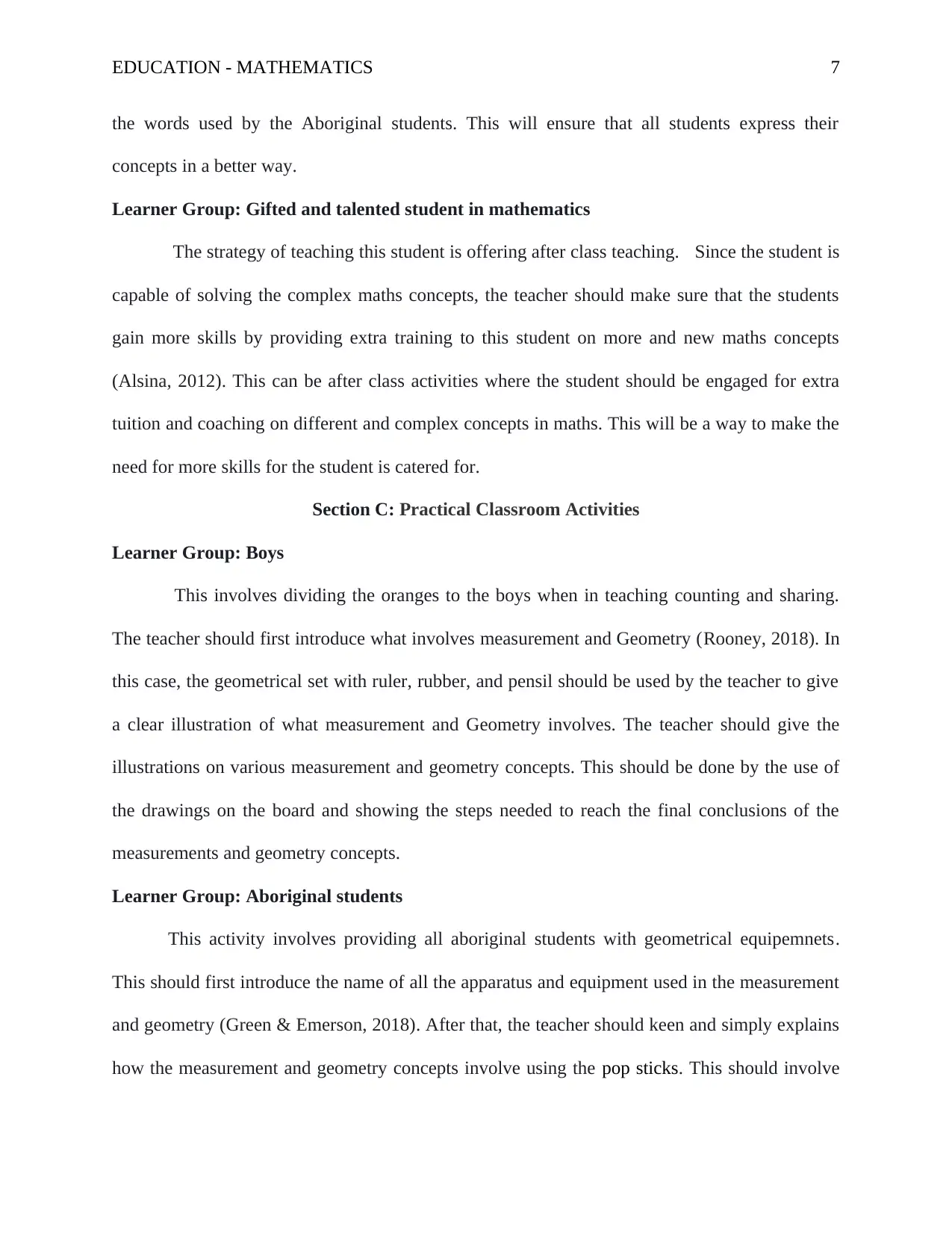
EDUCATION - MATHEMATICS 7
the words used by the Aboriginal students. This will ensure that all students express their
concepts in a better way.
Learner Group: Gifted and talented student in mathematics
The strategy of teaching this student is offering after class teaching. Since the student is
capable of solving the complex maths concepts, the teacher should make sure that the students
gain more skills by providing extra training to this student on more and new maths concepts
(Alsina, 2012). This can be after class activities where the student should be engaged for extra
tuition and coaching on different and complex concepts in maths. This will be a way to make the
need for more skills for the student is catered for.
Section C: Practical Classroom Activities
Learner Group: Boys
This involves dividing the oranges to the boys when in teaching counting and sharing.
The teacher should first introduce what involves measurement and Geometry (Rooney, 2018). In
this case, the geometrical set with ruler, rubber, and pensil should be used by the teacher to give
a clear illustration of what measurement and Geometry involves. The teacher should give the
illustrations on various measurement and geometry concepts. This should be done by the use of
the drawings on the board and showing the steps needed to reach the final conclusions of the
measurements and geometry concepts.
Learner Group: Aboriginal students
This activity involves providing all aboriginal students with geometrical equipemnets.
This should first introduce the name of all the apparatus and equipment used in the measurement
and geometry (Green & Emerson, 2018). After that, the teacher should keen and simply explains
how the measurement and geometry concepts involve using the pop sticks. This should involve
the words used by the Aboriginal students. This will ensure that all students express their
concepts in a better way.
Learner Group: Gifted and talented student in mathematics
The strategy of teaching this student is offering after class teaching. Since the student is
capable of solving the complex maths concepts, the teacher should make sure that the students
gain more skills by providing extra training to this student on more and new maths concepts
(Alsina, 2012). This can be after class activities where the student should be engaged for extra
tuition and coaching on different and complex concepts in maths. This will be a way to make the
need for more skills for the student is catered for.
Section C: Practical Classroom Activities
Learner Group: Boys
This involves dividing the oranges to the boys when in teaching counting and sharing.
The teacher should first introduce what involves measurement and Geometry (Rooney, 2018). In
this case, the geometrical set with ruler, rubber, and pensil should be used by the teacher to give
a clear illustration of what measurement and Geometry involves. The teacher should give the
illustrations on various measurement and geometry concepts. This should be done by the use of
the drawings on the board and showing the steps needed to reach the final conclusions of the
measurements and geometry concepts.
Learner Group: Aboriginal students
This activity involves providing all aboriginal students with geometrical equipemnets.
This should first introduce the name of all the apparatus and equipment used in the measurement
and geometry (Green & Emerson, 2018). After that, the teacher should keen and simply explains
how the measurement and geometry concepts involve using the pop sticks. This should involve
Paraphrase This Document
Need a fresh take? Get an instant paraphrase of this document with our AI Paraphraser
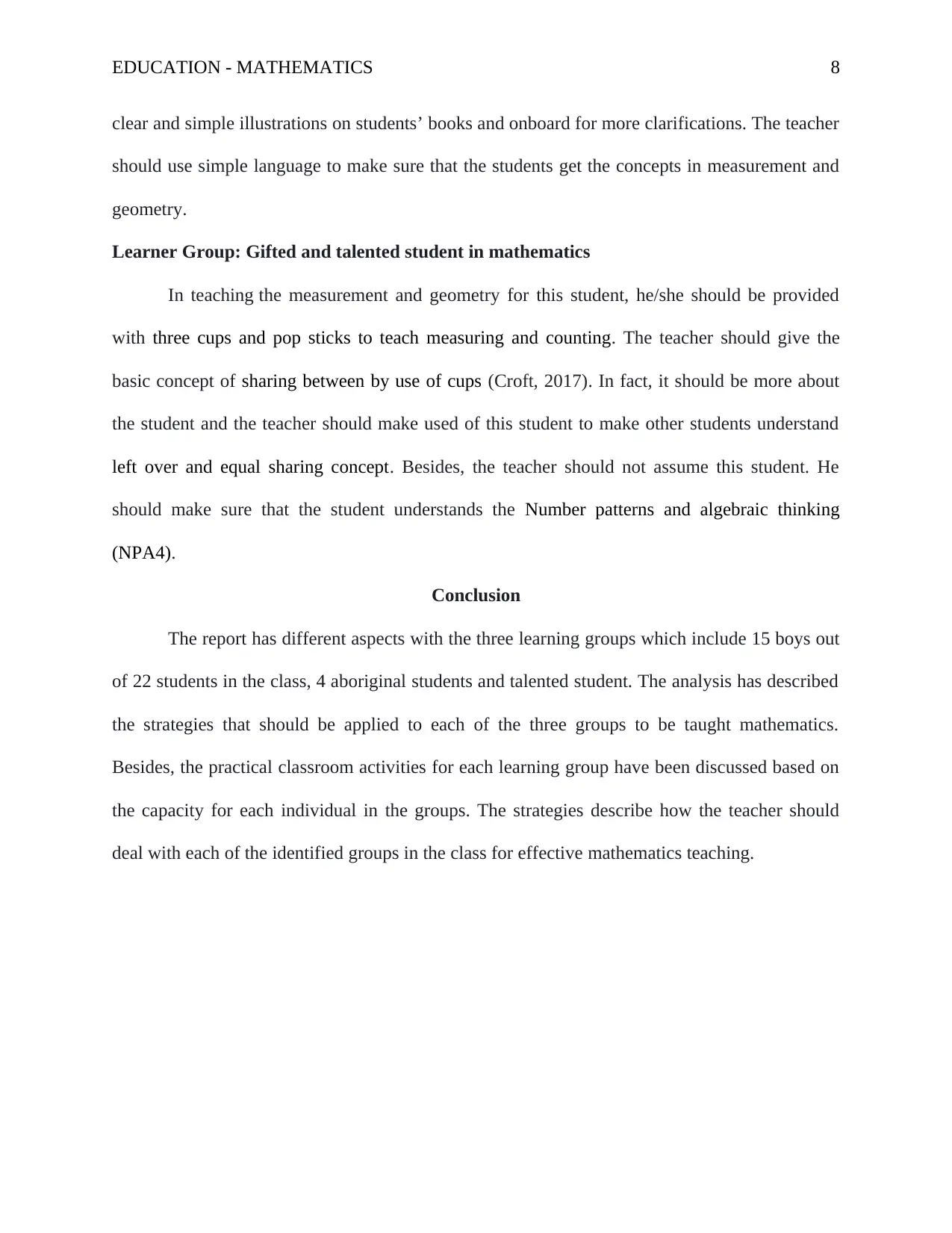
EDUCATION - MATHEMATICS 8
clear and simple illustrations on students’ books and onboard for more clarifications. The teacher
should use simple language to make sure that the students get the concepts in measurement and
geometry.
Learner Group: Gifted and talented student in mathematics
In teaching the measurement and geometry for this student, he/she should be provided
with three cups and pop sticks to teach measuring and counting. The teacher should give the
basic concept of sharing between by use of cups (Croft, 2017). In fact, it should be more about
the student and the teacher should make used of this student to make other students understand
left over and equal sharing concept. Besides, the teacher should not assume this student. He
should make sure that the student understands the Number patterns and algebraic thinking
(NPA4).
Conclusion
The report has different aspects with the three learning groups which include 15 boys out
of 22 students in the class, 4 aboriginal students and talented student. The analysis has described
the strategies that should be applied to each of the three groups to be taught mathematics.
Besides, the practical classroom activities for each learning group have been discussed based on
the capacity for each individual in the groups. The strategies describe how the teacher should
deal with each of the identified groups in the class for effective mathematics teaching.
clear and simple illustrations on students’ books and onboard for more clarifications. The teacher
should use simple language to make sure that the students get the concepts in measurement and
geometry.
Learner Group: Gifted and talented student in mathematics
In teaching the measurement and geometry for this student, he/she should be provided
with three cups and pop sticks to teach measuring and counting. The teacher should give the
basic concept of sharing between by use of cups (Croft, 2017). In fact, it should be more about
the student and the teacher should make used of this student to make other students understand
left over and equal sharing concept. Besides, the teacher should not assume this student. He
should make sure that the student understands the Number patterns and algebraic thinking
(NPA4).
Conclusion
The report has different aspects with the three learning groups which include 15 boys out
of 22 students in the class, 4 aboriginal students and talented student. The analysis has described
the strategies that should be applied to each of the three groups to be taught mathematics.
Besides, the practical classroom activities for each learning group have been discussed based on
the capacity for each individual in the groups. The strategies describe how the teacher should
deal with each of the identified groups in the class for effective mathematics teaching.
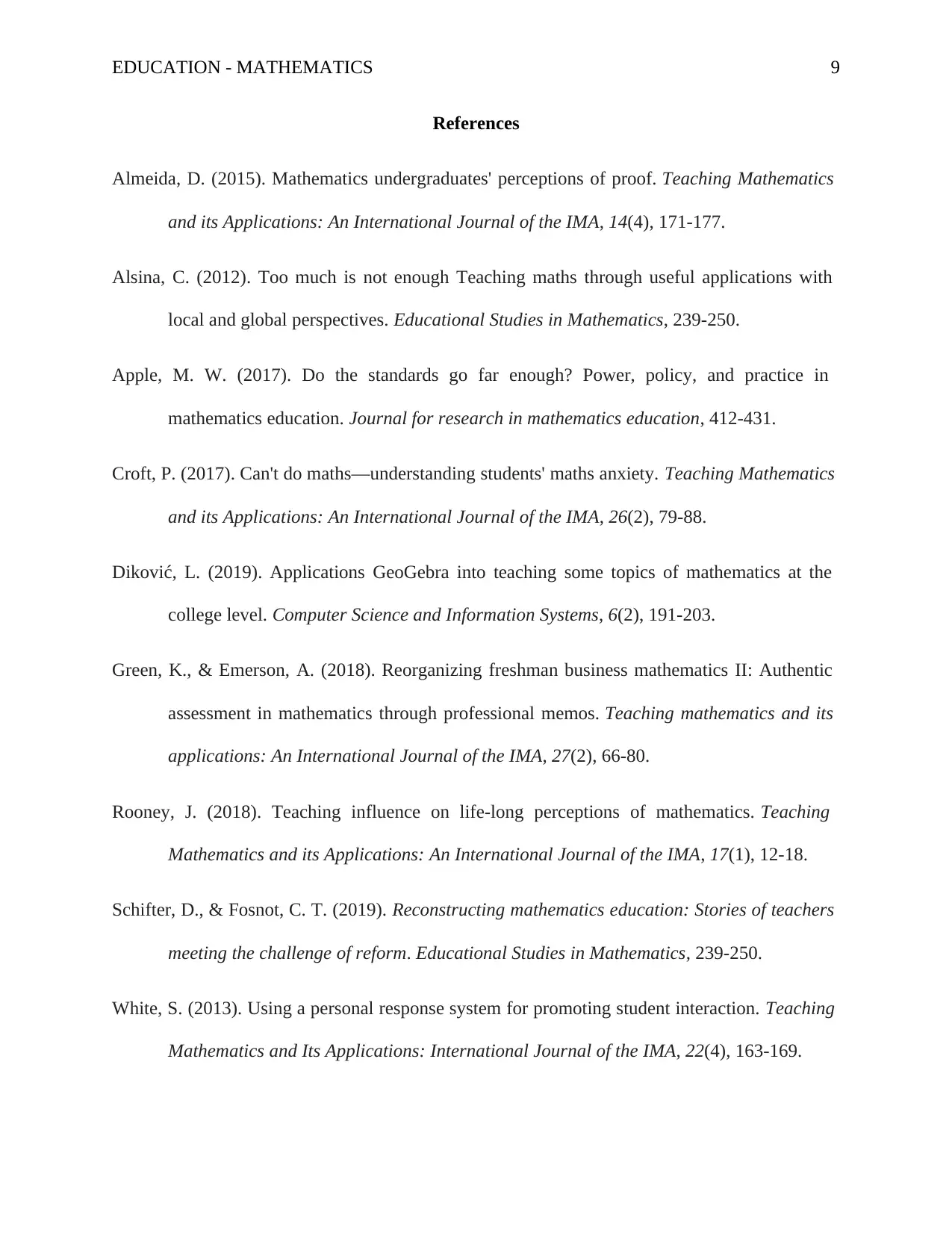
EDUCATION - MATHEMATICS 9
References
Almeida, D. (2015). Mathematics undergraduates' perceptions of proof. Teaching Mathematics
and its Applications: An International Journal of the IMA, 14(4), 171-177.
Alsina, C. (2012). Too much is not enough Teaching maths through useful applications with
local and global perspectives. Educational Studies in Mathematics, 239-250.
Apple, M. W. (2017). Do the standards go far enough? Power, policy, and practice in
mathematics education. Journal for research in mathematics education, 412-431.
Croft, P. (2017). Can't do maths—understanding students' maths anxiety. Teaching Mathematics
and its Applications: An International Journal of the IMA, 26(2), 79-88.
Diković, L. (2019). Applications GeoGebra into teaching some topics of mathematics at the
college level. Computer Science and Information Systems, 6(2), 191-203.
Green, K., & Emerson, A. (2018). Reorganizing freshman business mathematics II: Authentic
assessment in mathematics through professional memos. Teaching mathematics and its
applications: An International Journal of the IMA, 27(2), 66-80.
Rooney, J. (2018). Teaching influence on life-long perceptions of mathematics. Teaching
Mathematics and its Applications: An International Journal of the IMA, 17(1), 12-18.
Schifter, D., & Fosnot, C. T. (2019). Reconstructing mathematics education: Stories of teachers
meeting the challenge of reform. Educational Studies in Mathematics, 239-250.
White, S. (2013). Using a personal response system for promoting student interaction. Teaching
Mathematics and Its Applications: International Journal of the IMA, 22(4), 163-169.
References
Almeida, D. (2015). Mathematics undergraduates' perceptions of proof. Teaching Mathematics
and its Applications: An International Journal of the IMA, 14(4), 171-177.
Alsina, C. (2012). Too much is not enough Teaching maths through useful applications with
local and global perspectives. Educational Studies in Mathematics, 239-250.
Apple, M. W. (2017). Do the standards go far enough? Power, policy, and practice in
mathematics education. Journal for research in mathematics education, 412-431.
Croft, P. (2017). Can't do maths—understanding students' maths anxiety. Teaching Mathematics
and its Applications: An International Journal of the IMA, 26(2), 79-88.
Diković, L. (2019). Applications GeoGebra into teaching some topics of mathematics at the
college level. Computer Science and Information Systems, 6(2), 191-203.
Green, K., & Emerson, A. (2018). Reorganizing freshman business mathematics II: Authentic
assessment in mathematics through professional memos. Teaching mathematics and its
applications: An International Journal of the IMA, 27(2), 66-80.
Rooney, J. (2018). Teaching influence on life-long perceptions of mathematics. Teaching
Mathematics and its Applications: An International Journal of the IMA, 17(1), 12-18.
Schifter, D., & Fosnot, C. T. (2019). Reconstructing mathematics education: Stories of teachers
meeting the challenge of reform. Educational Studies in Mathematics, 239-250.
White, S. (2013). Using a personal response system for promoting student interaction. Teaching
Mathematics and Its Applications: International Journal of the IMA, 22(4), 163-169.
⊘ This is a preview!⊘
Do you want full access?
Subscribe today to unlock all pages.

Trusted by 1+ million students worldwide
1 out of 9
Related Documents
Your All-in-One AI-Powered Toolkit for Academic Success.
+13062052269
info@desklib.com
Available 24*7 on WhatsApp / Email
![[object Object]](/_next/static/media/star-bottom.7253800d.svg)
Unlock your academic potential
Copyright © 2020–2025 A2Z Services. All Rights Reserved. Developed and managed by ZUCOL.





